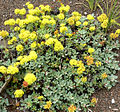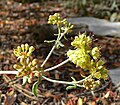Eriogonum umbellatum
| Eriogonum umbellatum | |
|---|---|

| |
| Eriogonum umbellatum var. hypoleium | |
| Scientific classification | |
| Kingdom: | Plantae |
| Clade: | Tracheophytes |
| Clade: | Angiosperms |
| Clade: | Eudicots |
| Order: | Caryophyllales |
| Family: | Polygonaceae |
| Genus: | Eriogonum |
| Species: | E. umbellatum
|
| Binomial name | |
| Eriogonum umbellatum | |
Eriogonum umbellatum is a species of wild buckwheat known by the common name sulphurflower buckwheat, or simply sulphur flower.
Description[edit]
It is an extremely variable plant and hard to identify because individuals can look very different from one another. Also, there are many varieties. It may be a perennial herb blooming by summer[1] with stems 10 centimetres (4 in) tall[citation needed] and two to six clusters of flowers, with a whorl of leaves below the stems,[1] or a sprawling shrub approaching 2 metres (6+1⁄2 ft) high and wide.[citation needed] The leaves are usually woolly and low on the plant, and the flowers come in many colors from white to bright yellow to purple.
Varieties[edit]
- E. u. var. argus - often nearly hairless leaves and bright yellow flowers; limited to the Klamath Mountains
- E. u. var. dichrocephalum - found throughout much of the western United States
- E. u. var. furcosum - a low shrub native to the Sierra Nevada
- E. u. var. glaberrimum - (green buckwheat) - a nearly hairless, white-flowered species
- E. u. var. humistratum - (Mt. Eddy buckwheat) - a rare northern California endemic
- E. u. var. juniporinum - (juniper buckwheat) - an uncommon plant of eastern California and western Nevada
- E. u. var. subalpinum - (sulfur buckwheat) - similar to Eriogonum eriogonum but has wider and more spoon-shaped leaves
- E. u. var. torreyanum - (Donner Pass buckwheat) - known from fewer than 10 occurrences near the Donner Pass
- E. u. var. versicolor - bears pinkish-brown flowers with bright stripes
Distribution and habitat[edit]
It is native to western North America from California to Colorado to central Canada, where it is abundant and found in many habitats, including the sagebrush steppe and alpine areas.[1]
Ecology[edit]
It is a popular larval host, feeding the bramble hairstreak, desert green hairstreak, lupine blue, Mormon metalmark, Rocky Mountain dotted blue, Sheridan's hairstreak, Sonoran metalmark, and western green hairstreak.[2] Additionally, goats and domestic sheep feed on the plant.[3]
Cultivation[edit]
The wildflower gardening author Claude A. Barr complemented sulphurflower buckwheat as a "treasure in appearance and in adaptation in my garden."[4] It is valued for its very low water usage for xeriscaping. The cultivar "Kannah Creek", a selection of Eriogonum umbellatum var. aureum, has been introduced to the garden trade by the Plant Select cooperative sponsored by Colorado State University and Denver Botanic Gardens.[5][6] It grows in USDA zones 4–8.[7]
-
E. umbellatum var. dichrocephalum
-
E. umbellatum var. humistratum (habit)
-
E. umbellatum var. humistratum (flowers)
-
E. umbellatum var. hypoleium (habit, William O. Douglas Wilderness)
-
E. umbellatum var. hypoleium (flowers)
-
E. umbellatum var. majus (flowers, Wenatchee Mountains)
-
E. umbellatum var. subaridum (flowers, Spring Mountains)
References[edit]
- ^ a b c Taylor, Ronald J. (1994) [1992]. Sagebrush Country: A Wildflower Sanctuary (rev. ed.). Missoula, MT: Mountain Press Pub. Co. p. 30. ISBN 0-87842-280-3. OCLC 25708726.
- ^ The Xerces Society (2016), Gardening for Butterflies: How You Can Attract and Protect Beautiful, Beneficial Insects, Timber Press.
- ^ Reiner, Ralph E. (1969). Introducing the Flowering Beauty of Glacier National Park and the Majestic High Rockies. Glacier Park, Inc. p. 32.
- ^ Barr, Claude A. (1983). Jewels of the plains : wild flowers of the Great Plains grasslands and hills. Minneapolis: University of Minnesota Press. p. 77. ISBN 0-8166-1127-0.
- ^ "Kannah Creek Buckwheat". Colorado Springs Utilities Xeriscaping. Colorado Springs Utilities. Retrieved 27 May 2023.
- ^ "From Grand Mesa, It's Kannah Creek® Buckwheat!". Plant Select. 30 November 1999. Retrieved 27 May 2023.
- ^ "Eriogonum umbellatum". Plant Finder. Missouri Botanical Garden. Retrieved 27 May 2023.
External links[edit]
 Media related to Eriogonum umbellatum at Wikimedia Commons
Media related to Eriogonum umbellatum at Wikimedia Commons- Jepson Manual Treatment
- Ethnobotany
- Photo gallery
- NatureServe secure species
- Eriogonum
- Flora of the Northwestern United States
- Flora of the Southwestern United States
- Flora of Alberta
- Flora of British Columbia
- Flora of New Mexico
- Flora of the Cascade Range
- Flora of the Rocky Mountains
- Flora of the Sierra Nevada (United States)
- Flora of the California desert regions
- Natural history of the California chaparral and woodlands
- Natural history of the California Coast Ranges
- Natural history of the Mojave Desert
- Natural history of the Peninsular Ranges
- Natural history of the San Francisco Bay Area
- Natural history of the Transverse Ranges








